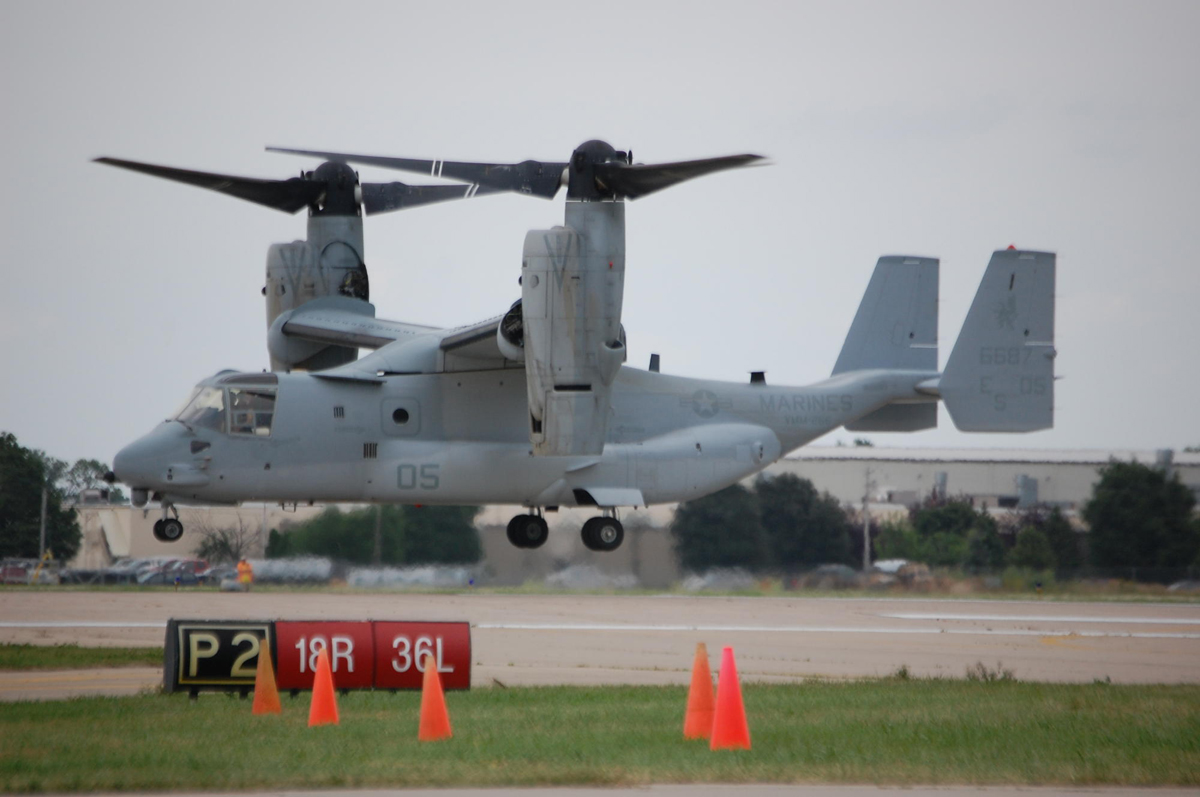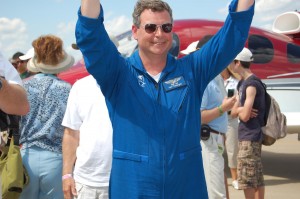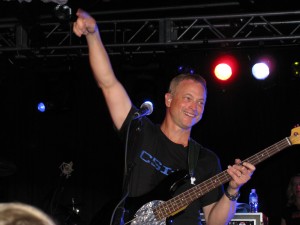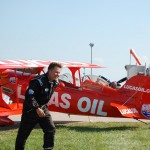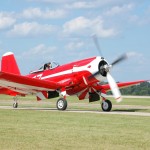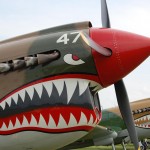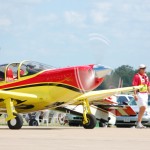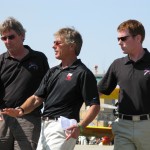By Henry M. Holden

The V-22 Osprey, one of the more unique aircraft flown by the U.S. Navy and Marine Corps, made an appearance at AirVenture this year for the first time.
The EAA AirVenture’s 56th annual weeklong fly-in opened on July 28. This year’s show welcomed more than 10,000 aircraft into Wisconsin’s Oshkosh-Wittman Regional Airport (OSH); 2,516 show airplanes, including homebuilt, ultralights and vintage models, were on exhibit.
This year’s aviation innovations and inventions included the Martin Jetpack, billed as the “first practical jetpack,” the largest cargo airplane in the world and the Rocket Racing League.
The weather for the week was warm and generally clear, with fluctuating humidity—almost perfect. The atmosphere seemed to be something old and new, tried and true, cutting edge, vintage, metal, wood, composite, slow and supersonic—something for everyone. The formula seems to have worked.
“This year’s convention exceeded my expectations, considering the high fuel cost and a struggling economy,” said Tom Poberezny, EAA president and AirVenture chairman. “At the start of the show, the expectation was that high fuel prices and the generally poor economy would sap attendance, but the numbers held, and it’s due to the quality of the show itself.”
The estimated 540,000 in attendance was a slight decrease from 2007 and nearly equal to 2006.
“This year’s Oshkosh was the shot of enthusiasm, inspiration and economic boost that aviation needed,” Poberezny said, stating that the abundance of programs, both daytime and evening, transformed AirVenture.
“This year, people stayed on the grounds at night,” he said. “Crowds at the Theater in the Woods ranged from 4,000 to 10,000 people. Every night in the Fly-In Theater there were 5,000 to 6,000 people. A total of 1,200 activities throughout the week made AirVenture a 24/7 event.”
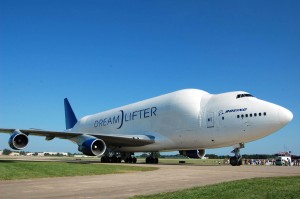
The 65,000-cubic foot cargo area of the Dreamlifter carries the aircraft’s fuselage, wings and horizontal stabilizer.
A collection of aircraft found together no place else in the world headlined the features and attractions that made this “The World’s Greatest Aviation Celebration.”
“It’s been said that if an aircraft has flown, is flying, or will fly, it will eventually make it to Oshkosh,” Poberezny said. “That diversity of aircraft makes AirVenture a place like no other to discover and explore the passion for flight in all of its unique forms.”
Some of the air show performers included the AeroShell and Collaborators formation aerobatic teams, Matt Chapman, Julie Clark, Kyle Franklin, Mike Goulian, Gene Soucy, Sean Tucker and Patty Wagstaff.
Attractions included the V-22 Osprey, which flew demonstrations and took part in ground displays.
“The Osprey is one of the few U.S. military aircraft that had never appeared at AirVenture,” Poberezny said.
The Boeing 787 Dreamlifter, a gargantuan modified Boeing 747-400, made its first major appearance in Oshkosh. One of only three in the world, it touched down on Monday just before the Foreigner concert began, drawing the attention of the thousands who had gathered to see the band.
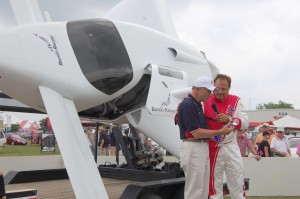
Tom Poberezny (left) and Granger Whitelaw discuss the first public performance of a Rocket Racing League aircraft.
A former China Airlines B-747 remained on the field for 24 hours. It spent a year undergoing modifications in Taiwan. The unpressurized cargo hold, which loads through a swinging tail, makes the Dreamlifter three feet longer that the standard B-747-400. A 65,000 cubic foot cargo deck allows it to hold more cargo than any other airplane in the world.
The annual warbird activities included five warbird show performances with a 60-minute demonstration on Tuesday, and the explosive “Warbirds Spectaculars” on Friday and Saturday. Some of the stars of the show were the Boeing B-17 Flying Fortress, B-24 Liberator, B-25 Mitchell, P-51 Mustang, F4U Corsair, and one of the world’s most advanced military jets, the F-22 Raptor. A newcomer to the scene was the Nanchang CJ-6, the first indigenous Chinese-designed military aircraft trainer produced.
The RedStar Pilots Association celebrated the 50th anniversary of the Nanchang CJ-6, marking the anniversary of the aircraft’s production with a series of formation flights. Thirty-one CJ-6s flew in 5-0 formation. Of approximately 2,300 CJ-6s manufactured, about 220 are now in the U.S., many participating in air shows under the RedStar banner.
AeroShell Team minus key member
The AeroShell Aerobatic Team was minus one key member this year. Alan Henley faced several surgeries after falling from a chinning bar in mid-July. His wife, Jennifer, said that Henley was determined to beat the partial paralysis that resulted from the broken vertebrae in his neck.
As Henley lay in a hospital bed on Saturday afternoon, someone delivered a computer to his room. About an hour later, he received a streaming video of the world’s largest sky typed get well card, which simply read, “Get Well Alan.”
That’s not how Oregon Aero SkyDancer team members Steve Oliver, and his wife and partner, Suzanne Asbury-Oliver, planned it.

AeroShell Square was packed with an estimated 1,500 people to see the “rocket man” make the first ever-manned Martin Jetpack flight, billed as the “World’s First Practical Jetpack.” Developer Glenn Martin is on the far left.
“We didn’t know until hours later that Alan and Jennifer watched the skywriting in real time,” Oliver said. “Our original intent was to capture it in photos and video and send to them to cheer them up. The way it came together was incredible! At that moment, everyone on the grounds, in addition to the aerobatic community, was thinking of Alan and wishing him well.”
Rocket Racing League
The RRL unveiled its competition racing aircraft in a single-ship demonstration that opened Tuesday’s air show. This marked the first public flight of these aircraft since their spring introduction in New York.
A veteran of three space shuttle flights, RRL test pilot Rick Searfoss ignited the rocket racer’s engine. After a loud pop—produced by 1,500 pounds of thrust from a liquid oxygen and kerosene engine—and a short takeoff, Searfoss punched a hole in the sky, leaving a trail of 15-foot flames.
Due to limited fuel, Searfoss shut off the engine to cool it and then reignited it to continue his vertical climb and high G turns. After 10 minutes and several high-speed, low-altitude fly-bys, the rocket racer made a quiet landing, ending with a cooling-down period required by FAA regulations.
The Velocity Aircraft’s canard airframe is the base for the rocket-powered racer, which is outfitted with an XCOR Aerospace LOX engine capable of 1,500 to 2,000 lbs. of thrust.
“Today is truly a milestone,” said Granger Whitelaw, RRL founder and CEO. “This first flight proves that by bringing together the technological and business development power of the aerospace industry, we’ve changed the future of sports entertainment.”
The aircraft flew again on Friday and Saturday, expanding its routine to include some mild aerobatics.
Speed Blast category blasted
Jon Sharp and his Nemesis NXT set a world record in the 3 km C1-b Speed Blast category on Wednesday. He reached a speed of 356 mph, covering three kilometers in 18.75 seconds, smashing the current 19-year record of 331 mph. The weather conditions were less than desirable; 15 mph winds buffeted Sharp, producing a bumpy ride.
On Saturday, he attempted to break his own record, but only completed one pass before a mechanical issue caused him to scrub the second and final pass needed.
Rocket man
AeroShell Square was packed early Tuesday with an estimated 1,500 people to see the “rocket man” make the first ever-manned Martin Jetpack flight, billed as the “World’s First Practical Jetpack.”
Developer Glenn Martin stated that work on the Martin Jetpack began nearly 30 years ago.
“Such a flying machine has been part of our imagination for decades, highlighted
by science fiction movies such as ‘Buck Rogers’ more than 75 years ago,” Martin said. “Military attempts to produce a practical jetpack go back to the 1950s.”
The longest flight so far has been five and a half minutes, but most flights have lasted about 30 seconds, as this one did. The FAA restricted the flight to a hover, which went about five feet off the ground, with handlers holding the device back as the developer’s son, 16-year-old Harrison Martin, manipulated the controls.

On Wednesday, the Vision SJ50 jet arrived for its world debut. The red and white V-tail single-engine jet first flew July 3.
During the demonstration, most of the crowd could only see the top of the jetpack’s white composite frame. Those who could see seemed simultaneously surprised and disappointed. The noisy demonstration wasn’t quite up to the futuristic leap into the sky that many had expected.
Martin said that in one year, 10 models could be flying 30 minutes at altitudes of 500 feet. The cost will be about $100,000. The jetpack uses regular gasoline and complies with FAA ultralight regulations.
ElectraFlyer-C
Last year, Randall Fishman, president of Electric Aircraft Corp., flew his first electric-powered aircraft, a weight-shift trike, during AirVenture 2007, receiving the Grand Champion and Innovation award in the ultralight category. This year he brought his ElectraFlyer-C, an electric-powered, single-seat airplane that made its first flight earlier this summer.
Fishman’s ElectraFlyer-C airplane earned him the 2008 Dr. August Raspet Memorial Award for his accomplishment in developing and flying an electric-powered aircraft. EAA has presented the Raspet award annually since 1960 to a person who has made an outstanding contribution to the advancement of light aircraft design.
An 18-hp electric motor powers the ElectraFlyer-C. It cruises at 70 mph, stalls at 45 mph and has a top speed of 90 mph and a flight duration of one and a half hours. The motor drives a 45-inch, ground-adjustable, two-blade Powerfin carbon-fiber propeller, giving the ElectraFlyer-C a climb rate of 500 to 600 fpm.
The motor draws power from a custom-built lithium polymer battery pack, which has a life of 1,000 cycles. The battery pack, which weighs 78 lbs., produces 5.6-kilowatt hours. A 220-volt charger can recharge the battery pack in two hours, or six hours with a 110-volt charger. According to Fishman, the cost for a full recharge is 70 cents using a 110-volt charger, which can be carried as baggage on cross-country flights.
“People will like flying the airplane because there’s no vibration and it’s almost completely silent in the air,” Fishman said. “You can listen to your iPod or use a handheld radio without needing a helmet while in flight.”
Personal jets take center stage
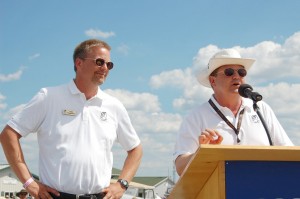
Dale (left) and Alan Klapmeier discuss the arrival of the new Cirrus Design SJ50 jet. First announced last year, the aircraft has been under development for four years.
On Wednesday, “The Jet,” now baptized as the Cirrus Design Vision SJ50 jet, made its world debut by making a low pass over the flight line before taxiing up to an enthusiastic round of applause at AeroShell Square. The red and white V-tail, single-engine jet has been in development for four years and first flew July 3.
Tom Poberezny congratulated Cirrus Design Corporation’s co-founders, Alan and Dale Klapmeier, who’ve been coming to the fly-in for 32 years, on their achievement.
“Oshkosh is the home of innovation, the place where Alan and Dale cultivated their passion for aviation,” Poberezny said. “Now this beautiful aircraft is entering a growing and exciting marketplace.”
Alan Klapmeier expressed his delight in being able to show the aircraft off at Oshkosh.
“This is the greatest place in the world to be this week of the year, and for us, this is a very long time coming,” he said. “It takes Cirrus to the next level.”
Dale Klapmeier said their getting close to realizing their dream of offering the public a turbo-fan powered aircraft with higher performance than the company’s piston aircraft. The Williams International FJ33-4A-19 fanjet is expected to deliver a maximum cruise speed of about 300 knots to the SJ50, which will have a service ceiling of 25,000 feet. The aircraft features a flexible five plus two seating configuration. The company has orders for more than 500 aircraft, and Cirrus projects certification and first deliveries will take place in 2011, at a price of $1 million to $1.3 million.
At the welcoming ceremony, air taxi company SATSair announced it would add the SJ50 to its fleet. It’s the first commercial entity to announce plans to operate the Cirrus jet. CEO Steve Hanvey said SATSair has noted a significant amount of customer interest in the very light jet category.
Dale and Alan Klapmeier later received Oshkosh’s Key to the City award, during the annual Mayor’s Breakfast held Friday morning on the University of Wisconsin-Oshkosh campus.
PiperJet
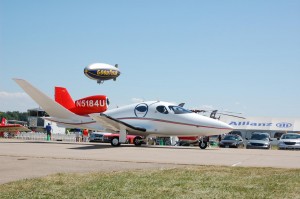
The Goodyear blimp returned for a second straight appearance. It flew orbits around the field and anchored at Pioneer Airport. The Eclipse 400 jet is in the foreground.
Piper Aircraft Inc. President Bob Kromer announced the first flight of the single-engine PiperJet, from its factory in Vero Beach, Fla., and displayed a mock-up.
“The PiperJet represents 71 years of a lot of hard work by a lot of people, and a lot of loyal customers that have seen us to this point,” he said.
Certification and the first delivery are expected in the fourth quarter of 2011. The PiperJet’s price is $2.19 million.
“It’s a very big airplane with a big ramp presence,” Kromer said, drawing attention to its all-metal construction. “We make most of the airframe without rivets. The wing is a thing of sheet-metal beauty. Aluminum airplanes aren’t dead; we can make a smooth, aerodynamically clean airframe out of metal.”
Roel Pieper takes key role at Eclipse
One of the surprising announcements at AirVenture was that Roel Pieper was replacing Vern Raburn, founder and long-time CEO of Eclipse Aviation Corp. Pieper is the chairman of the board of directors and president of European Technology and Investment Resource Center, Eclipse’s majority shareholder. In a brief statement, Raburn said he believed Eclipse fundamentally changed aviation, but he acknowledged that the company’s development didn’t occur as quickly or as smoothly as planned.
Eclipse reiterated its commitment to producing its single-engine Eclipse 400, which it introduced as a “concept” aircraft at AirVenture 2007. The Eclipse 400 performed some modified aerobatics during the showcase fly-bys.
LSAs on stage—an iconic beginning
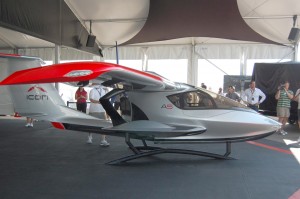
The Icon A5 LSA mock-up exhibits a design that engineers went “outside the box” to create, including innovate folding electric wings.
The ICON A5 LSA, which made its first flight July 9, sports a design that engineers went “outside the box” to create. At the unveiling, Poberezny introduced Kirk Hawkins, ICON founder.
The former airline pilot and Air Force fighter pilot said he’s flown every kind of aircraft, including F-16s, but the best flying experiences he’s had were “flying low and slow with friends in sport aircraft.”
“I believe we’ve lost the passion and the romance in flying, and ICON intends to bring that back,” he said. “We want to create an aircraft that people will have a visceral, emotional response to—ICON is here to put the sport back into sport flying.”
The ICON A5, powered by a reliable 100 hp Rotax ULS engine driving a three-bladed propeller, features a high-strength, lightweight carbon-fiber airframe. It runs on both auto and aviation fuel.
The aircraft can electrically fold its wings for highway trailering, and an SUV can tow it in a specially made container trailer. Weight restrictions will give customers options for either landing gear or manual folding wings, or no landing gear and motorized folding wings.
The A5 has an estimated top speed of about 100 kts, with fuel efficiency up to 20 mpg. Other unique features include a sports car-like cockpit with an MP3 player music port, and a Seawings platform for easy access and docking on water.
“We need to bring new people of all ages into aviation with products that appeal to people today,” Poberezny said. “ICON has done that.”
The ICON A5’s design includes safety features such as a prop guard, angle of attack indicator and a quick deploying ICON Complete Airplane Parachute.
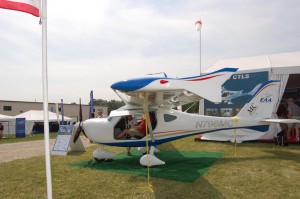
Flight Design USA, maker of one of the most popular LSA designs in the U.S., unveiled a new metal model for those who prefer aluminum airframes.
“Since we’ve started taking orders, it’s been overwhelming,” Hawkins said.
The first production ICON A5 is expected in late 2010. About 214 positions have been reserved so far on the $140,000 aircraft.
Even with a less than encouraging economic horizon, Hawkins says he has funding in place for the production program.
“There’s such a latent demand, I don’t see the economy being a problem,” he said. “Twenty countries already have adapted LSA rules. It’s going global.”
The maximum takeoff weight is 1,430 lbs., giving it a useful load of 430 to 550 lbs., depending on aircraft configuration.
Flight Design’s metal airplane
Although composite aircraft designs have benefited Flight Design USA, makers of one of the most popular LSA designs in the U.S., it unveiled a new model for those who prefer aluminum airframes. The Flight Design MC—for metal concept—is essentially the same as the Flight Design CT-LS, but constructed mainly of metal. It’s aimed to appeal to the flight school and training market. Matthias Betsch, CEO of Flight Design in Stuttgart, Germany, said the company has been working on the new design for three years, in response to customer requests.
The MC, with metal wings and tail, has a simpler tail structure than the CT-LS and features a lower cockpit sill for easier entry.
“This won’t be as fast as the LS, but that’s not what we’re looking for,” Betsch said. “The drop of 10 knots to 115 comes along with a sturdier landing gear, more cabin space, wider wings and reduced drag from the reshaped fuselage and double winglets.”
The LS carries about 50 pounds more load and has about 500 miles more range with full fuel. The MC is available with an 80 or 100 hp engine and with analog instruments or a glass cockpit. The LS is only available in glass.
SkyCatcher catches attention
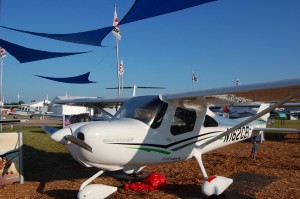
Cessna introduced its proof-of-concept SkyCatcher two years ago at AirVenture. This year Cessna brought the first production model of the aircraft, complete with a standard interior and final panel configuration.
Cessna Aircraft Company’s proof-of-concept 162 SkyCatcher has made regular appearances at air shows since its introduction two years ago at AirVenture. This year Cessna brought the real deal, the first production model of the all-metal aircraft, complete with a standard interior and final panel configuration. Cessna toned down the factory paint job from the vibrant treatment on the proof-of-concept airplane.
The 162 prototype and the first production model have accumulated more than 90 hours for the American Society of Testing and Materials; Cessna will complete testing by year’s end.
The 162 is expected to cruise at 118 knots, with a maximum range of 470 nm. Its gross weight is 1,320 lbs., with a service ceiling of 15,500 feet and a useful load of 490 lbs. The cabin width at shoulder height is 44 inches, the same width as the much larger six-place Cessna 206 Stationair.
An LSA car
Terrafugia Inc. unveiled its proof-of-concept prototype Transition flying car. CEO Carl Dietrich prefers to call it a “roadable aircraft,” and plans to have it flying by the end of this year.
“We’re close to starting driving tests and are on track for its first flight by the end of 2008,” Dietrich said.
He expects certification as an LSA, but that will require additional refinements to reduce weight in the next version.
“Transition will use super-unleaded auto gas, so you can drive it up to your local gas station for a fill up,” Dietrich said. “It’ll burn about 4.5 gallons per hour at 100 knots, and on the highway it will give you 30-40 mpg. It’ll be LSA certified by the end of 2009, in the same time frame as the first deliveries take place.”
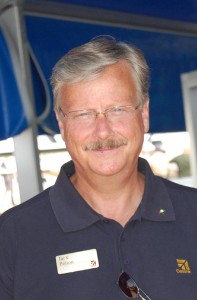
Cessna President Jack Pelton received the 2008 Freedom of Flight Award, the EAA’s highest honor, for his vision for the LSA development of the SkyCatcher.
The prototype is powered by a Rotax 912S. Funding so far has been through private and anonymous investors.
“We’ve been very successful at raising money,” he said.
The company is now taking $5,000 fully refundable deposits on the $194,000 aircraft. More than 50 delivery positions have been reserved.
Dietrich said that Transition, with a 400 nm range, offers the option of landing at a nearby field and then driving to your destination.
“It’ll transition from car to airplane, or vice versa, in 15 seconds,” he said.
Diamond exhibits Austro AE 300 engine
Diamond Aircraft Industries exhibited the new Austro AE 300 engine at the show. The Austro is a 170-hp, next-generation turbo-diesel engine that burns jet-A. It will soon be available on the DA42 Twin Star. The AE 300 offers 26 percent more power than the engines currently on the DA42, according to Diamond, for better takeoff and climb performance, better single-engine performance and more speed.
Diamond, which has been working with MB Tech (a Mercedes Benz company) and Bosch to develop the engine, expects European certification within a few months. Features include a clutch-less gearbox, a cast-iron crankcase, integral oil/coolant heat exchanger and improved turbocharger air induction and cooling systems.
Diamond has been working hard to get the engine certified and online after problems with its regular diesel supplier, Thielert Aircraft Engines, which entered insolvency in April. The insolvency and the decisions of the insolvency administrator, including cancelling warranty support and the prorating of time-between-overhaul for the Thielert engines, led Diamond to temporarily suspend production of the DA42.
Lycoming unveils new fuel-injected engine
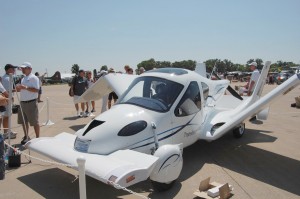
Terrafugia unveiled its proof-of-concept prototype Transition flying car. CEO Carl Dietrich plans to have the “roadable aircraft” flying by the end of this year.
Lycoming Engines unveiled a new LSA fuel-injected engine, derived from a model well-known to GA. The IO-233-LSA is a four-cylinder engine that produces 100 hp at 2,400 rpm, and has a 2,400-hour TBO. The engine is rooted in the familiar 235-model line, but the company saved weight by using lighter parts. The engine has a dry weight of 200 to 210 pounds and burns 5.25 gph at 75 percent power. It comes standard with dual electronic spark ignition, throttle body fuel injection and a lightweight starter and alternator, and can run on ethanol-free unleaded fuel. Lycoming expects to bring the engine to market next year.
Rolls Royce and Mooney partner
On Wednesday, Rolls Royce and Mooney announced that they’ve signed a memo of agreement on a joint engineering project. The MOA will explore development of a turbine-powered Mooney M20 airframe. The airframe will use the Rolls-Royce RR500 TP engine, which the company officially launched earlier in the week at AirVenture. Rolls Royce’s development plans for the RR500 TP include FAA certification during the fourth quarter of 2010, followed by production engine deliveries in 2011.
Affordable Flying Center
With fuel costs skyrocketing and maintenance, tie down and landing fees going up, the EAA wants to help keep GA alive at small airports by helping pilots save money.
The EAA designed the newly created Affordable Flying Center to address one of the biggest challenges facing many pilots: how to maintain a reasonable budget and yet keep their passion for flying alive. Staffers and volunteers were available all week to answer questions about the various affordable aircraft on display.

On Friday morning, hundreds of female aviators, most wearing pink WomenVenture T-shirts, turned out at AeroShell Square to set the record for the largest number of female pilots gathered in one place.
The aircraft in the center included the Alatus-M ultralight motorglider, which sells for under $30,000; a Pietenpol Air Camper, which can be built from plans, or found used, for under $10,000; and a Sonerai II, selling for about $15,000.
The center had a full slate of forums on topics like fuel efficiency, FAQ for buying an LSA and more.
WomenVenture
On Friday morning, hundreds of female aviators, most wearing pink WomenVenture T-shirts, turned out at AeroShell Square to set the record for the largest number of female pilots gathered in one place. Foremost among them were members of the Women Airforce Service Pilots; aerobatic pilots, including Patty Wagstaff and Julie Clark; and Dr. Peggy Chabrian, Women in Aviation International president and founder.
The photo op was part of WomenVenture, a joint effort between EAA and WAI to interest more women in aviation through programs, seminars, speakers and events. Women make up about six percent of the total number of pilots in the U.S.—about 35,784 of 590,349 pilots. That six percent figure has remained unchanged for the last 20 years.
A rock invasion
On opening day, the power and excitement of live aircraft shifted to the excitement of the legendary rock band Foreigner. The band took to the stage at AeroShell Square for a free performance before an audience of 10,000. Foreigner has attracted multiple generations of fans around the world, and the band has sold more than 70 million albums worldwide.
“We know the opening-day concert has become a favorite at AirVenture in just the two previous years that they’ve been held,” Poberezny said. “Ford has again made it possible for this popular tradition to continue by supporting the appearance of top-name musical entertainment at Oshkosh.”
Lt. Dan Band
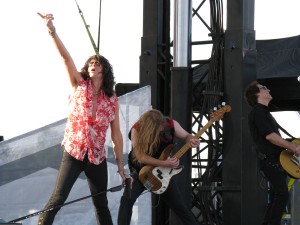
On opening day, a free performance by Foreigner attracted an audience of 10,000 to the stage at AeroShell Square.
Friday evening saw a second free concert with Gary Sinise and his Lt. Dan Band. The success of the film “Forrest Gump”—and the character Lt. Dan, played by Sinise, who received an Academy Award nomination for the role—led him and Chicago composer/Vietnam veteran Kimo Williams to assemble a group of musicians named for the movie character. Formed in 2003, the Lt. Dan Band has toured with the USO in at least 30 venues.
Prior to the start of the high-energy concert, the audience watched a video of Sinise’s uncle, a B-17 navigator during WWII. Sinise wanted to give his uncle a ride in a surviving B-17 bomber, and eventually did with the cooperation of the Disabled American Veterans and the Warbirds of America.
“We’re pleased to have this opportunity to work closely with the DAV and present the Lt. Dan Band concert at AirVenture 2008,” said Rick Siegfried, Warbirds of America president. “Our members share a patriotic link with Gary Sinise—a deep appreciation for the job our military does on our behalf. It’s a natural fit to have the Lt. Dan Band and the DAV be part of the AirVenture experience.”
Several thousand fans filled the Theater in the Woods to overflowing, with people dancing in the aisles and on the grass surrounding the theater. The band drew the audience into the evening by connecting on a personal level, even before the first song was over.
EAA celebrates 30,000th homebuilt aircraft
Each year the EAA features record setters in aviation. This year, one newly finished homebuilt aircraft—one of 972 homebuilts that flew in—received recognition as the honorary 30,000th homebuilt aircraft.
“We checked with the FAA and it’s impossible to determine exactly which aircraft will be the 30,000th,” said Charlie Becker, EAA director of member programs. “This is a huge milestone for the homebuilt movement that EAA couldn’t let go unnoticed. So, we created another way to recognize this major achievement as a focal point of our celebration.”
That lucky homebuilder was Bob Noll, from Yuma, Ariz.; his airplane is a blue Van’s Aircraft RV-9A. For three and a half years, Noll worked on the plane in his garage with the help of his wife, Debbie, and his three children. On Thursday, he received an FAA certificate for what will be recognized as the symbolic 30,000th homebuilt airplane in the U.S.
During construction, Noll logged 1,500 hours of building time, but he estimates he spent another 1,000 hours of unrecorded building time. Noll had no formal aircraft building training.
“I’m an accountant by trade, and you really need a support base when you start a project like this,” he said.
A view from the ground
Next year, visitors will find major renovations and site expansion underway. Plans for this expansion began in 2005 when a task force reached out to visitors for feedback.
“EAA members’ comments and ideas about the grounds have been a major part of this process,” Poberezny said. “These contributions from EAA members helped shape the vision of the future while preserving the culture we hold so dear.”
A big “X” will provide the core design foundation for the expansions. The design will connect the campgrounds, museum, parking and exhibits.
Some of the upgrades to be completed next year will be new showers and restrooms, expanded WiFi, new paths and roads for people and vehicles and an exhibition facility linking the north exhibit hangars A and C. More upgrades will take place after the 2009 show.
For more information, visit [http://www.airventure.org].
- Established in 1997, the U.S. Air Force Heritage Flight program commemorated the Air Force’s 50th anniversary. It has continued each year since then, with today’s state-of-the-art fighters flying in close formation with warbirds from earlier generations.
- Mike Wiskus leaps from his modified Pitts S-1-11b SS to greet a fan.
- Bob Odegaard taxies his Goodyear F2G-1 Super Corsair back to AeroShell Square after an exciting air race. Each day the performers put on a simulated race before the start of the show.
- This is the first time the one-of-a-kind TU-2S two-place U-2 spy plane appeared at AirVenture.
- John Travolta flew his Boeing 707 into the show. Travolta is also rated on the Boeing 747.
- Warbirds are a perennial favorite. This year, 404 warbirds showed up, with most performing during the week.
- Matt Chapman returns in his CAP 231 EX after a stunning aerial performance.
- Maj. Paul Moga opened the weapons bay on a low pass for a quick look inside the F-22.
- L to R: Eric Tucker, Bill Stein Sean Tucker and Ben Freelove, members of the Collaborators, talk about their performance.











